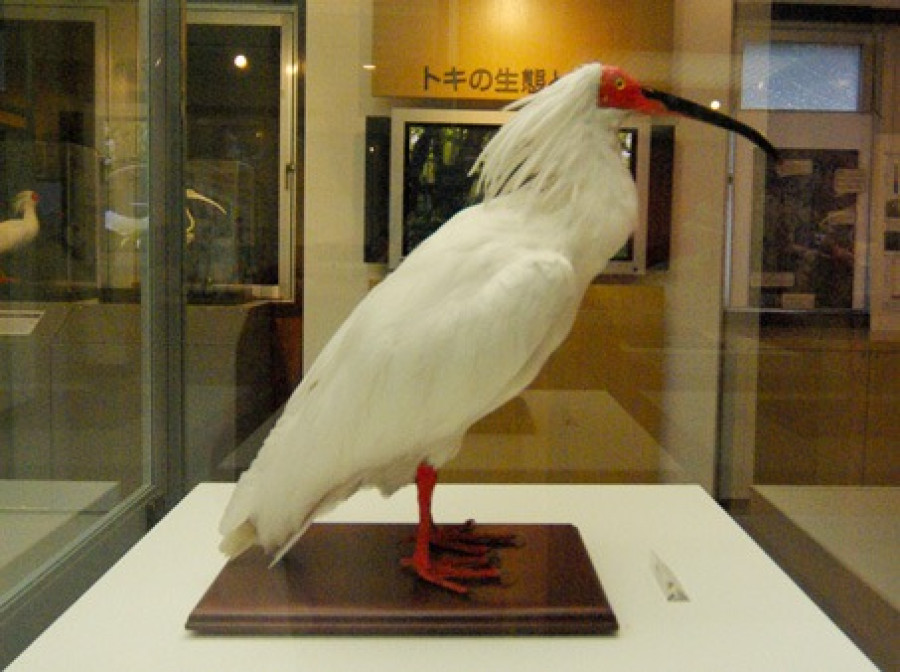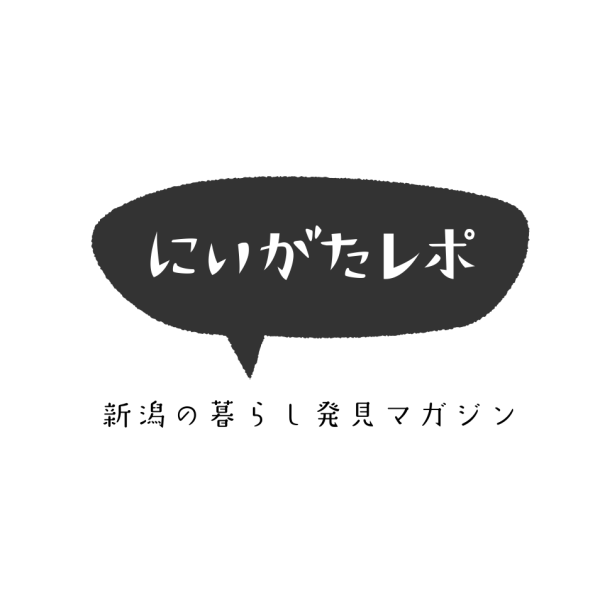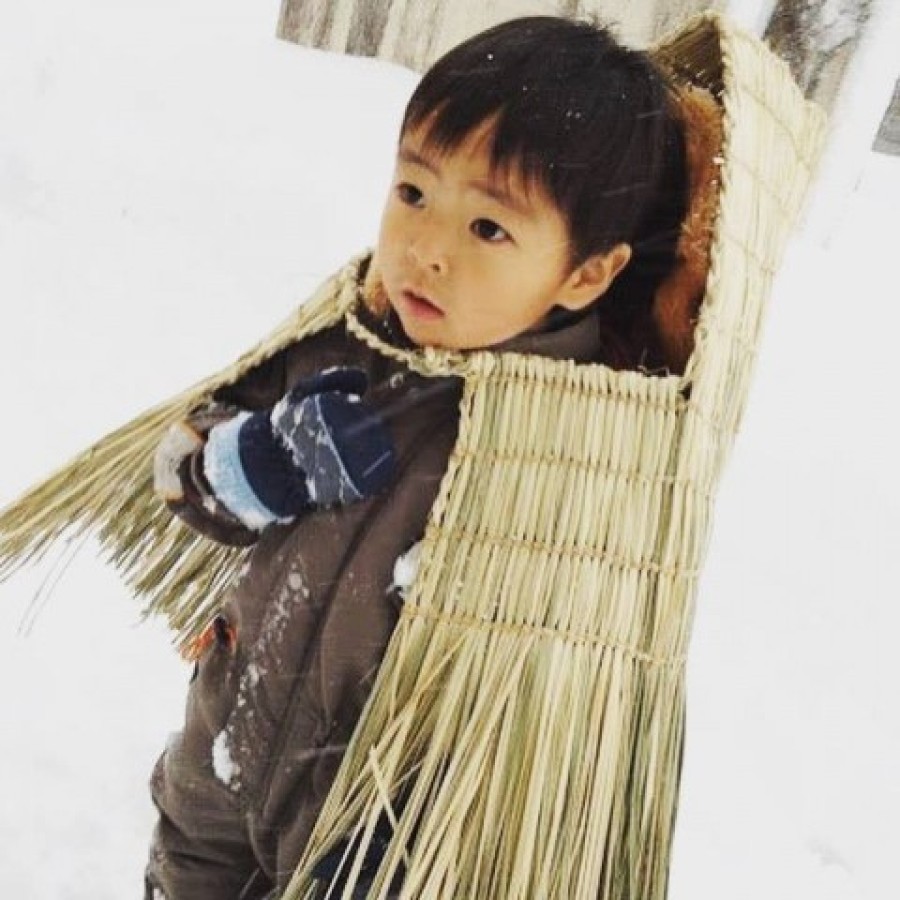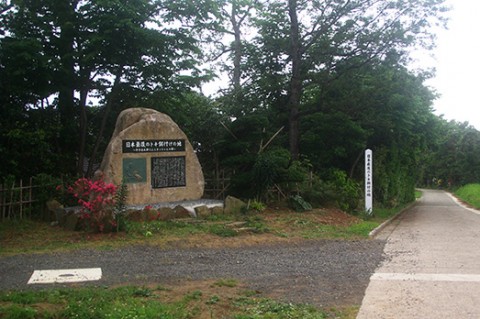
There is a pink information board along the national road near Nishimikawa in Mano, Sado. It reads: "Monument to Uji Kintaro-san and Kin-chan, the last crested ibis baiting site in Japan." I followed the information board and went and looked.
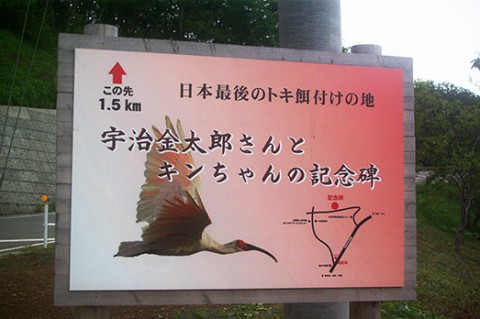
The 'monument' was located in a rural area with orchards and rice fields. It is quite a splendid monument.
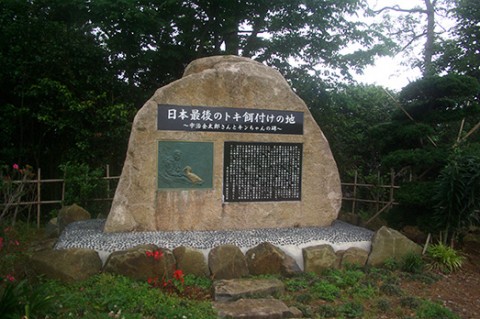
The "Kin-chan" refers to the "Kin", which was said to be the "last crested ibis in Japan". The monument depicts Uji Kintaro (deceased) feeding the "Kin".
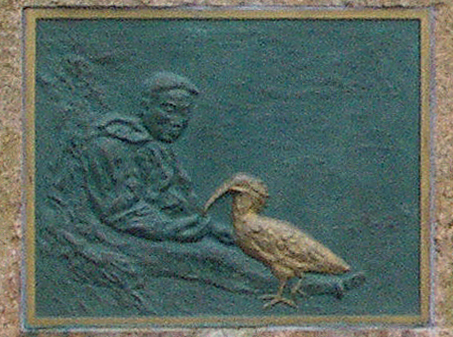
Kintaro Uji was the person who successfully fed the 'kin' and furthermore protected them. This monument was erected in 2009 on the site where Mr Uji first fed the 'Kin'.
However, the story of Uji Kintaro and Kin is not well known to the public.
The story of Uji-san and "Tokiko".
In 1968, a single juvenile crested ibis strayed onto the Mano lands. At the time, the number of crested ibis in the wild was dwindling, with only one flock remaining in Noto and one on Sado Island, and extinction was imminent. The juvenile bird strayed from its flock and came to Mano.
The year before, the Sado Ibis Conservation Centre was opened and attempts at artificial breeding had just begun. At the time, the full ecology of the crested ibis was not known and breeding was difficult.
The (then) town of Mano asked for instructions from the Environment Agency and decided to try to observe and feed the crested ibis. They asked Kintaro Uji, a farmer who was the director of the local community centre and a member of the Wild Bird Society, to act as an ibis inspector. In fact, Mr Uji had never seen a real crested ibis before.
Every morning, Mr Uji put on the same clothes and walked many kilometres to visit the crested ibis, calling out "khoi, khoi khoi" to them. At first he started from a distance, then gradually shortened the distance and gave them loaches to feed.
The crested ibis, which were wary at first, have come to open their hearts only to Mr Uji. When they hear Mr Uji's call, they fly to him, and when they spot him, they land at his feet and nibble food directly from his palm.
Uji-san also called them "Tokiko, Tokiko" and cared for them as if they were his own children. Until then, no one else had ever had such a heart-to-heart relationship with a wild crested ibis.
That winter, there was a heavy snowfall. Mr Uji was worried about Tokiko, so he and his wife looked around for her in the bad weather and were very relieved when they found she was safe.
A capture team sent by the Environment Agency arrived in Mano. The risk of the ibis dying is high if they are left as they are, so it was decided to capture them and breed them artificially.
However, the 'Tokiko' was wary of the capture team approaching to catch it with the Musou net and ran away. Each time this happened, Mr Uji had to rebuild a relationship of trust with Tokiko. This was repeated many times, and in the end the capture failed. The capture team instructed the town of Mano (at the time) to capture the ibis, and then left the area.
The troubled town asked Uji-san to protect 'Tokiko'. Uji-san also understood that 'Tokiko' could not survive without protection.
Still, he couldn't make up his mind, saying, "I can't catch an ibis that trusts me.
However, the season moves from winter to spring. Natural enemies such as hawks, crows and wild dogs start to move in. The crested ibis have grown up and their range of movement has widened to the point where they can no longer be monitored. In spring, agricultural work begins and fields are sprayed with pesticides.
It was conclusive that 'Tokiko' would not survive until the summer if she was not protected.
One day in March, 'Tokiko' stopped showing up at the feeding ground. Uji and the Mano Town Board of Education staff desperately searched for the ibis, and they also threw away their duties and searched all over the town. They finally found her seven kilometres away from where she was usually found. After much deliberation, Uji finally decides to capture Tokiko.
As usual, 'Tokiko' landed with Mr Uji and, after being fed, sat down to snuggle up to him. Uji-san captured 'Tokiko', holding her gently in his arms.
'Tokiko' didn't make any noise or resist, she remained still and motionless, just 'kwah' in a small voice.
At that time, large tears were falling from Uji's eyes.
I am the world's biggest traitor."
At the time, the technology for artificial breeding of crested ibis was not yet probable, and the ibis that began to be bred at the conservation centres were dying one after another.
Shortly after Uji-san protected the 'ibis child', he was informed that one of the ibis at the conservation centre had died. At this stage, four out of five artificially bred crested ibis had died. Mr Uji wondered if he should open the window of his car and let the 'crested ibis' escape.
Uji-san continued to regret for the rest of his life that he had deprived Tokiko of her freedom with his own hands. He couldn't bear to see her so depressed and encouraged her by saying, "If I hadn't captured her, she would probably be dead by now, attacked by wild dogs", but she could only reply, "... I'm the biggest traitor in the world...".
As if whipping my ageing body, I climbed the 593 stone steps of Ugajin-sama every month and stayed overnight to pray for the long life and prosperity of 'Tokiko''s offspring.
It is said that he was concerned about 'Tokiko', even in a rant shortly before his death.
(Reference: "The Last Words of the Vermilion Heron" by Teruyuki Kobayashi / 1998 issue)
Kin continued to live.
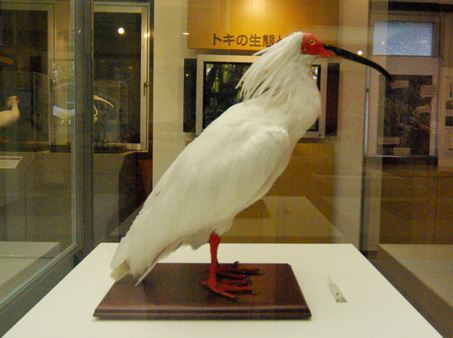 Kin (blank / crested ibis forest park).
Kin (blank / crested ibis forest park).
Tokiko" was transferred to the Ibis Conservation Centre and named "Kin" after one of Uji Kintaro's names. The first director of the Sado Ibis Conservation Centre, Hirokazu Chikatsuji (deceased), was responsible for breeding her.
In 1981, the last five remaining birds on Sado were protected and transferred to the Sado Ibis Conservation Centre. At this time, all the crested ibis in the wild had disappeared. (It was only a few months later that crested ibis were discovered in Yang County, China.)
Although she did not produce any offspring, Uji's wish was granted and the 'Kin' lived on. While other crested ibises passed away due to illness, accident or life expectancy, Kin continued to live on, even though it was the last one.
Long-standing records of the breeding of 'Kin', which crossed over from juvenile to old age, were later used for the artificial breeding of crested ibis in Yang County, China.
In 1999, a mating pair of crested ibis is received from China. The following year, chicks were born and soon the number of crested ibis at the conservation centre began to increase. Within a few years, the number exceeded 25, and the once-extinct crested ibis was beginning to make a 'comeback'. At the same time, on Sado Island, work was underway to create an environment in which the crested ibis could coexist in harmony.
In October 2003, the 'Kin' closed its long life, as if to witness the addition of a new member to its flock. At an estimated age of 36 years, it was the longest ever recorded for an ibis in captivity and an exceptionally long life for a bird.
In his later years, 'Kin' hardly moved a day, but earlier that day, he suddenly flapped his wings and flew high into the air. It then crashed into the ceiling.
No one knows what the 'Kin' was thinking when it suddenly decided to fly, or where it wanted to go.
But I am sure he was reunited with his favourite Uji in heaven.
The 'kin' connected to the release of the crested ibis.
If 'Kin' had died at the same time as the other crested ibis, the Sado Ibis Conservation Centre would probably have been closed as its role had been completed. If that had happened, there would probably have been no more ibis mating gifts from China.
Some people often say that the Japanese Crested Ibis is extinct and that what we have now is the Chinese Crested Ibis. That is certainly true. The fact that Japan once drove the crested ibis to extinction cannot be erased.
However, it is precisely because "Kin" has continued to live on that it exists today. We would like people to know that there was the strong desire of Mr Chikatsuji and Mr Uji, and that "Kin" responded to that desire.
Spotlight.
Monument to Uji Kintaro and Kinchan.
- Sado City, Tasuki area
Sado Japanese Crested Ibis Conservation Centre (Crested Ibis Resource and Exhibition Centre).
- 377-4, Niibo Nagaune, Sado City, Niigata Prefecture, Japan
- Opening hours 8.30 am - 5.00 pm (closing date for entry 4.30 pm).
- Closed Mondays (open every Monday from Mar-Nov), year-end and New Year holidays.
- Co-operation fee Adults (high school students and above): 400 yen per person / Small people (elementary and junior high school students): 100 yen per person
advertisement


